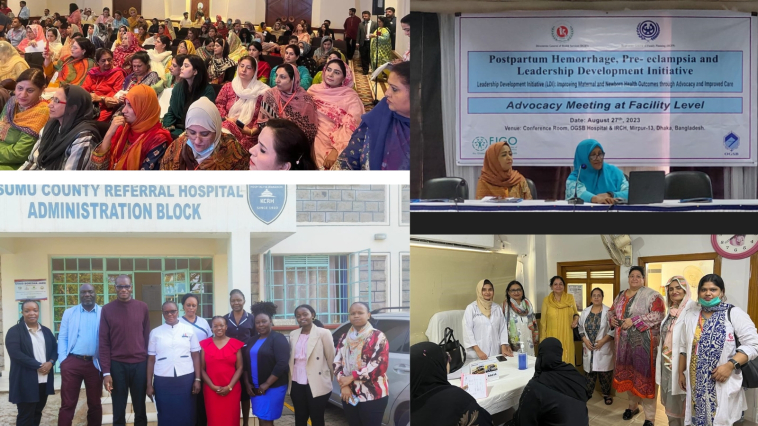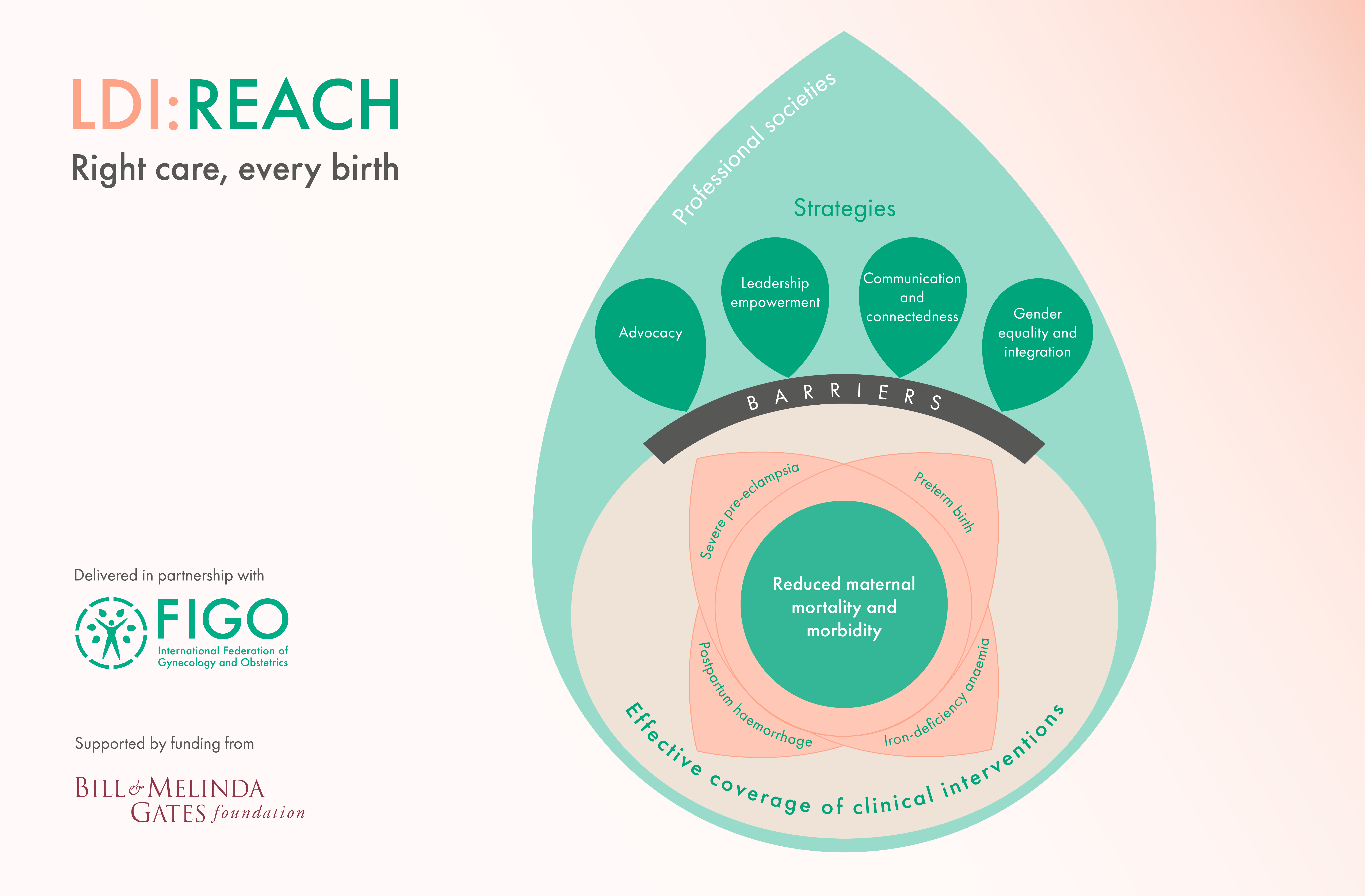Celebrating a year of FIGO’s Leadership Development Initiative: Removing barriers for Effective Access and Coverage of maternal Healthcare

As we mark the end of the first year of the Leadership Development Initiative: Removing barriers for effective access and coverage of maternal healthcare (LDI:REACH), we take a moment to reflect on the journey we have embarked upon and celebrate some of the achievements that have defined this year.
FIGO’s LDI:REACH aims to deliver increased adoption of and quality improvement in clinical practice to reduce maternal and newborn morbidity and mortality. The core objective of the programme is as follows:
- Increase the effective coverage of two specified clinical interventions within four facilities
- Address barriers hindering the effective coverage of the identified clinical interventions
- Implement applied strategies to eliminate these barriers and enhance uptake and adoption of best clinical practices, through leadership empowerment, advocacy and integration of gender diversity and equality.
LDI:REACH focuses on the following clinical areas: E-MOTIVE for PPH, use of magnesium sulphate for severe pre-eclampsia and eclampsia during labour and birth, management of iron deficiency anaemia during pregnancy and use of antenatal corticosteroids for pre-term birth. Countries involved in the initiative are Bangladesh, Ethiopia, India (Bihar and Uttar Pradesh), Kenya, Nigeria and Pakistan.

Project approach
Barrier Assessment Tool (BAT)
We have created a tool to assess barriers to effective coverage of selected clinical interventions in the six project countries, focusing on target facilities at national and regional level. Society-led teams have prioritised barriers identified and the activities that will allow action to remove or reduce them in order to facilitate the adoption and provision of quality care.
“Turkana County is faced with unique maternal health challenges and has been described as a laboratory for disaster as it faces a lot of barriers when it comes to women accessing quality care. The BAT will help reveal the gaps in maternal health and will pioneer innovative intervention methods with the aim of setting new standards in the county. This is a game-changing tool that will make a lasting impact in the lives of the women together with their families and more effort will be put towards overcoming the barriers and creating positive change in the County.”
- Dr. Gilchrist Lokoel, County Director of Health Services/CEO Lodwar County Referral Hospital, Kenya
Clinical Monitoring and Evaluation (M&E) framework
We have developed, in collaboration with each country team, a clinical M&E framework to measure the effective coverage of the clinical intervention. Effective coverage measures the extent to which individuals with a health need receive the appropriate clinical intervention and have a positive health outcome as a result. It can be expressed as a percentage e.g. 75% of PPH patients delivering at the facility receive E-MOTIVE and have a safe delivery. Country teams are using data collection tools to gather useful insight and information on both interventions within their facilities on a monthly basis. This will facilitate the calculation of measuring effective coverage.
Gender Analysis
A comprehensive gender analysis has been undertaken for all six countries involved in the initiative. We have developed gender planning and activities to support tackling the barriers, and established a network of 15 women leaders within the societies. These 15 women – our LDI Voices - have been interviewed to establish a baseline on their experiences. We will be talking to them throughout the project to create 15 longitudinal case studies and learn from their experiences.
Leadership Empowerment Series
We have successfully conducted a 10-week Leadership Empowerment Series to focus on strengthening leadership skills and break gender barriers. Country teams are currently engaged in developing their own national leadership curriculum to form applied leadership training to tackle the identified barriers.
“If I could have known the art and science of being a leader from my very beginning, if I could be a better leader, I could have achieved more for the people – for my society, for my fellow mates, for my patients”
- Leadership Empowerment Series participant, Bangladesh
Key achievements
In Year 1, together with FIGO, the six national societies have secured achievements across the project’s core areas.
Clinical
- The Learning Webinar on E-MOTIVE successfully reached almost 70 participants.
- FIGO has published two statements on the project clinical areas: uterotonics for PPH and IV iron for anaemia.
- At the FIGO World Congress in Paris, Dr Zubair (Pakistan) demonstrated how to create a calibrated drape out of available, low-cost materials.
- The team in India have developed a clinical curriculum for E-MOTIVE for PPH and IV iron for anaemia which will be delivered throughout the project.
Advocacy
- The Ministry of Health in Kenya has published a technical report on PPH resourcing, advocating for increased funding and guidance on procurement, supply, storage and distribution of PPH essentials.
- The Bangladesh team is developing regional-level advocacy teams to strengthen local advocacy.
- The Pakistan team successfully advocated for E-MOTIVE to be integrated into national PPH protocols.
Leadership
- Leadership training in Ethiopia reached Ministry of Health representatives alongside key society personnel.
- In Nigeria, 67 facility-level champions are poised to deliver step-down training to local teams.
- In Kenya, leadership training was developed and validated across stakeholder groups and is now available via the e-learning portal.
Gender
- Colleagues in Kenya engaged with the Kenya Women Parliamentary Association (KEWOPA) to advocate for family-friendly legislation and better enforcement of gender policies.
- Advocacy in Nigeria successfully brought a female doctor into a previously all-male Executive Committee of the society.
- In Kenya, the society has passed a constitutional amendment to ensure gender equity across the President/Vice-President and Secretary/Deputy Secretary teams starting with the February 2024 elections.
Looking ahead
With the project’s foundation now firmly in place, our member societies will continue to build on the work initiated in Year 1, implementing activities to remove or reduce impact of barriers at national, regional and facility level and increase effective coverage for the target clinical intervention. Simultaneously, our national societies will continue to implement strategies to support the ongoing efforts for barrier elimination and reduction, identifying opportunities for leadership strengthening and gender and advocacy activities where applicable.
FIGO's LDI:REACH team is in the process of evaluating the next steps for the FIGO Leadership Empowerment Series, while actively working to establish shared learning platforms and collaboration among country teams to exchange insights and lessons learned.
As we continue our work into Year 2, we express our deepest gratitude to the unwavering dedication of all member societies involved in the initiative. Their dedication and commitment has enabled us to achieve the successes we share today.